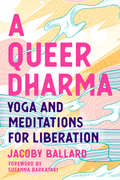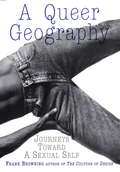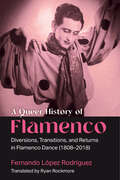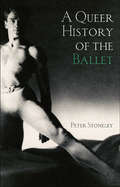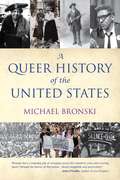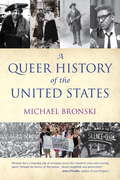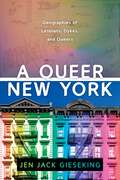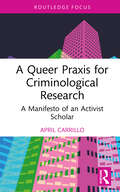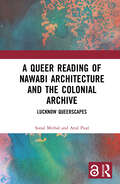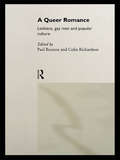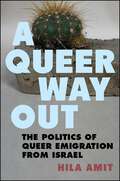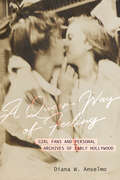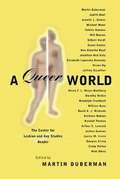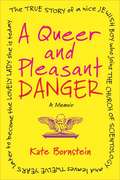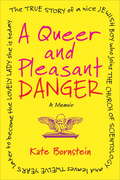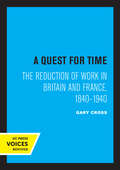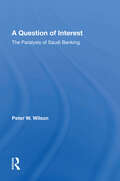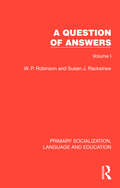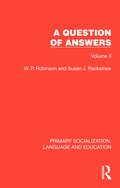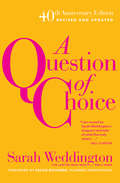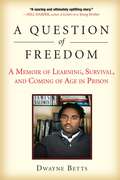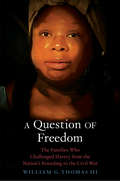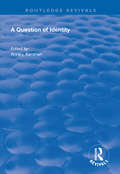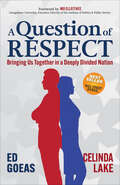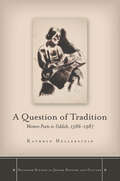- Table View
- List View
A Queer Dharma: Yoga and Meditations for Liberation
by Jacoby BallardQueer critique, queer practice: embodied teachings for healing from trauma and social injustice.Jacoby Ballard provides an empowering and affirming guide to embodied healing through yoga and the dharma, grounded in the brilliance, resilience, and lived experiences of queer folks.Part I deconstructs the ways mainstream yoga perpetuates queer- and transphobia and other systemic oppressions, exploring the intersections of yoga, capitalism, cultural appropriation, and sexual violence. Ballard also addresses the trauma--complex, vicarious, historical, and collective--perpetuated against queer communities. In response, he offers tools for self-compassion, tonglen, lovingkindness, and grounding, and helps readers explore questions like: • What is trauma? How is it a product of injustice--and how can healing it create justice? • The world won't stop being homo- and transphobic, so how do I encounter that in a way that does the least harm? • How do we love what is uniquely trans about us? • What are affinity groups, and why do we need them?In part II, Ballard offers a queer-centered, fully embodied, and equity-rooted practice with meditations, practices, and sequences for processing and healing from trauma individually and in community. He explains concepts like lovingkindness, letting go, compassion, joy, forgiveness, and equanimity through a queer lens, and pairs each with corresponding meditations, practices, and beautiful line drawings of queer bodies.Enhanced with stories from Ballard's personal practice and professional experience teaching yoga in schools, prisons, conferences, and his weekly Queer and Trans Yoga class, A Queer Dharma is a guidebook, reclamation, and unapologetically queer heart offering for true healing and transformation.
A Queer Geography
by Frank BrowningThe Author of the best-selling The Culture of Desire journeys into the minds of gay men in America and around the world to discover how their lives - and their desires - are shaped by the time, place, and culture in which they live.
A Queer History of Flamenco: Diversions, Transitions, and Returns in Flamenco Dance (1808–2018)
by Fernando López RodríguezA Queer History of Flamenco offers a groundbreaking exploration of flamenco through the lenses of queer theory and cultural studies. Previous histories have provided a largely distorted image about why, where, and how people have done flamenco—as well as who has performed flamenco. Yet feminists, transvestites, butches, femmes, the Spanish Roma, disabled people, guiris, and “incomprehensible” artists have been determined to do things differently without giving up their flamenco status. In this skillful translation of his book Historia queer del flamenco, Fernando López Rodríguez draws on diverse archival materials as well as his own lived experience and artistic practice, unearthing queer flamenco histories, voices, and perspectives that were previously unknown, avoided, or purposely hidden. Tracing flamenco’s development from its birth up to the contemporary era, the book places flamenco within significant historical periods such as the Spanish Civil War, Franco’s dictatorship, the transition to democracy, and the economic crisis of 2008, up to contemporary performances of the late 2010s. In taking a queer approach to History, the author abandons antiquated debates about purities and impurities; anecdotes about the lives of artists that are completely detached from their processes of creation; and myths about geniuses who seem to make art alone and completely detached from their collaborators and the historical, social, economic and artistic moment in which they lived. A Queer History of Flamenco is not only about the present and the queerness of people living, performing, or creating in it, but also about flamenco’s past in which so many queer artists and practices and their lives have remained unearthed and unaddressed.
A Queer History of the Ballet
by Peter StoneleyDesigned for students, scholars and general readers with an interest in dance and queer history, A Queer History of the Ballet focuses on how, as makers and as audiences, queer men and women have helped to develop many of the texts, images, and legends of ballet. Presenting a series of historical case studies, the book explores the ways in which, from the nineteenth century into the twentieth, ballet has been a means of conjuring homosexuality – of enabling some degree of expression and visibility for people who were otherwise declared illegal and obscene. Studies include: the perverse sororities of the Romantic ballet the fairy in folklore, literature, and ballet Tchaikovsky and the making of Swan Lake Diaghilev’s Ballets Russes and the emergence of queer modernity the formation of ballet in America the queer uses of the prima ballerina Genet’s writings for and about ballet. Also including a consideration of how ballet’s queer tradition has been memorialized by such contemporary dance-makers as Neumeier, Bausch, Bourne, and Preljocaj, this is an essential book in the study of ballet and queer history.
A Queer History of the United States
by Michael BronskiThe first book to cover the entirety of lesbian, gay, bisexual, and transgender history, from pre-1492 to the present. In the 1620s, Thomas Morton broke from Plymouth Colony and founded Merrymount, which celebrated same-sex desire, atheism, and interracial marriage. Transgender evangelist Jemima Wilkinson, in the early 1800s, changed her name to "Publick Universal Friend," refused to use pronouns, fought for gender equality, and led her own congregation in upstate New York. In the mid-nineteenth century, internationally famous Shakespearean actor Charlotte Cushman led an openly lesbian life, including a well-publicized "female marriage." And in the late 1920s, Augustus Granville Dill was fired by W. E. B. Du Bois from the NAACP's magazine the Crisis after being arrested for a homosexual encounter. These are just a few moments of queer history that Michael Bronski highlights in this groundbreaking book. Intellectually dynamic and endlessly provocative, A Queer History of the United States is more than a who's who of queer history: it is a book that radically challenges how we understand American history. Drawing upon primary documents, literature, and cultural histories, noted scholar and activist Michael Bronski charts the breadth of lesbian, gay, bisexual, and transgender history, from 1492 to the 1990s, and has written a testament to how the LGBT experience has profoundly shaped our country, culture, and history. A Queer History of the United States abounds with startling examples of unknown or often ignored aspects of American history-the ineffectiveness of sodomy laws in the colonies, the prevalence of cross-dressing women soldiers in the Civil War, the impact of new technologies on LGBT life in the nineteenth century, and how rock music and popular culture were, in large part, responsible for the devastating backlash against gay rights in the late 1970s. Most striking, Bronski documents how, over centuries, various incarnations of social purity movements have consistently attempted to regulate all sexuality, including fantasies, masturbation, and queer sex. Resisting these efforts, same-sex desire flourished and helped make America what it is today. At heart, A Queer History of the United States is simply about American history. It is a book that will matter both to LGBT people and heterosexuals. This engrossing and revelatory history will make readers appreciate just how queer America really is.
A Queer History of the United States (ReVisioning American History #1)
by Michael BronskiWinner of a 2012 Stonewall Book Award in nonfictionThe first book to cover the entirety of lesbian, gay, bisexual, and transgender history, from pre-1492 to the present.In the 1620s, Thomas Morton broke from Plymouth Colony and founded Merrymount, which celebrated same-sex desire, atheism, and interracial marriage. Transgender evangelist Jemima Wilkinson, in the early 1800s, changed her name to “Publick Universal Friend,” refused to use pronouns, fought for gender equality, and led her own congregation in upstate New York. In the mid-nineteenth century, internationally famous Shakespearean actor Charlotte Cushman led an openly lesbian life, including a well-publicized “female marriage.” And in the late 1920s, Augustus Granville Dill was fired by W. E. B. Du Bois from the NAACP’s magazine the Crisis after being arrested for a homosexual encounter. These are just a few moments of queer history that Michael Bronski highlights in this groundbreaking book. Intellectually dynamic and endlessly provocative, A Queer History of the United States is more than a “who’s who” of queer history: it is a book that radically challenges how we understand American history. Drawing upon primary documents, literature, and cultural histories, noted scholar and activist Michael Bronski charts the breadth of lesbian, gay, bisexual, and transgender history, from 1492 to the 1990s, and has written a testament to how the LGBT experience has profoundly shaped our country, culture, and history. A Queer History of the United States abounds with startling examples of unknown or often ignored aspects of American history—the ineffectiveness of sodomy laws in the colonies, the prevalence of cross-dressing women soldiers in the Civil War, the impact of new technologies on LGBT life in the nineteenth century, and how rock music and popular culture were, in large part, responsible for the devastating backlash against gay rights in the late 1970s. Most striking, Bronski documents how, over centuries, various incarnations of social purity movements have consistently attempted to regulate all sexuality, including fantasies, masturbation, and queer sex. Resisting these efforts, same-sex desire flourished and helped make America what it is today. At heart, A Queer History of the United States is simply about American history. It is a book that will matter both to LGBT people and heterosexuals. This engrossing and revelatory history will make readers appreciate just how queer America really is. From the Hardcover edition.
A Queer New York: Geographies of Lesbians, Dykes, and Queers
by Jen Jack GiesekingWinner, 2021 Glenda Laws Award given by the American Association of GeographersThe first lesbian and queer historical geography of New York CityOver the past few decades, rapid gentrification in New York City has led to the disappearance of many lesbian and queer spaces, displacing some of the most marginalized members of the LGBTQ+ community. In A Queer New York, Jen Jack Gieseking highlights the historic significance of these spaces, mapping the political, economic, and geographic dispossession of an important, thriving community that once called certain New York neighborhoods home.Focusing on well-known neighborhoods like Greenwich Village, Park Slope, Bedford-Stuyvesant, and Crown Heights, Gieseking shows how lesbian and queer neighborhoods have folded under the capitalist influence of white, wealthy gentrifiers who have ultimately failed to make room for them. Nevertheless, they highlight the ways lesbian and queer communities have succeeded in carving out spaces—and lives—in a city that has consistently pushed its most vulnerable citizens away.Beautifully written, A Queer New York is an eye-opening account of how lesbians and queers have survived in the face of twenty-first century gentrification and urban development.
A Queer Praxis for Criminological Research: A Manifesto of an Activist Scholar (Queering Criminology and Criminal Justice)
by April CarrilloA Queer Praxis for Criminological Research provides an alternative research method, where researchers place themselves second to draw narratives from folx who are typically sought out by scholars because of their identity.Describing the author’s use of queer praxis during a recent study, the chapters of this book demonstrate how the rigor of qualitative research was achieved by utilizing a queer methodology. It presents how the author interviewed trans folx about their experiences with the criminal legal system; explores their volunteer work with a local group in the trans community; and discusses how, before collecting any data, they spent eight months being a part of their lives and witnessing their everyday experiences. Based on these experiences, the book reveals how individual researchers can increase academic rigor and transparency and cultivate skills to complete qualitative criminological work. Using personal anecdotes, expert advice, applied examples from study and instrument design, triumphs, and losses, the book puts forward the argument that we can integrate communities into our academic research in meaningful ways to further both the discipline and our pursuit of social justice. In doing so, it seeks to inspire researchers to apply these concepts in their own work, no matter the type of methodology, revealing that as criminologists whose data sets emerge from some of the most personal moments in people’s lives, we have a stronger obligation to ensure that our findings empower, not demoralize, marginalized people.Written to be both instructional and inspirational, A Queer Praxis for Criminological Research will be of great interest to students and scholars of criminology.
A Queer Reading of Nawabi Architecture and the Colonial Archive: Lucknow Queerscapes
by Sonal Mithal Arul PaulA Queer Reading of Nawabi Architecture and the Colonial Archive explores the architectural production of nawabs Asaf-ud-Daula and Wajid Ali Shah and reveals the colonial bias against queer expression. It offers methods of using queer strategies to read archival evidence against the grain and rewrite erased, overlooked, and suppressed histories.The book provides its readers a unique queer postcolonial architectural history of Lucknow from 1775–1857. It highlights the nawabs’ non-normative expressions, which not only offered a fierce resistance to the colonial enterprise but also were instrumental in furthering Lucknow as a cultural center. It simultaneously extracts parameters from queer studies and redefines them to illustrate ways in which queer architecture can be characterized. It reconstructs the footprint of nawabi architecture erased by the colonial enterprise and places it back on map—an exercise not undertaken meticulously until now. A Queer Reading of Nawabi Architecture and the Colonial Archive is intended for scholars and students of queer studies, postcolonial studies, architectural history, and the global south, as well as the citizens of Lucknow.
A Queer Romance: Lesbians, Gay Men and Popular Culture
by Paul Burston Colin RichardsonIt's here and it's queer - popular culture inhabits all our lives, whether it comes in the form of movies or magazines, TV or shopping. A Queer Romance brings together critics, writers and artists to debate the possibilites of popular culture for lesbians and gay men. In a collection that is in-yer-face but never out-to-lunch, the contributors variously revisit debates about the gaze to provide a new theory of Queer viewing; discuss texts coded as queer - from lesbian vampires to Hollywood's use of gay codes in mainstream films such as Top Gun and Black Widow; consider the sexual and cultural narratives at play in the world of home shopping catalogues; explore the pleasures and perils of gay cultural production, from the radically queer film-making of Monika Treut to the wild world of homocore fanzines, and address the possibilities of texts claiming to be for the gay spectator - from pornography `by women, for women and about women' to `Out' TV. The contributors to A Queer Romance don't all agree but, taken together, the collection argues strongly that everyone can have their queer moments.
A Queer Way Out: The Politics of Queer Emigration from Israel
by Hila AmitWinner of the 2019 Association for Middle East Women's Studies Book AwardThe very language of Zionism prizes the concept of immigration to Israel (aliyah, literally ascending) while stigmatizing emigration from Israel (yerida, descending). In A Queer Way Out, Hila Amit explores the as-yet-untold story of queer Israeli emigrants. Drawing on extensive fieldwork in Berlin, London, and New York, she examines motivations for departure and feelings of unbelonging to the Israeli national collective. Amit shows that sexual orientation and left-wing political affiliation play significant roles in decisions to leave. Queer Israeli emigrants question national and heterosexual norms such as army service, monogamy, and reproduction. Amit argues that emigration itself is not only a political act, but one that pioneers a deliberately unheroic form of resistance to Zionist ideology. This fascinating study enriches our understandings of migration, political activism, and queer forms of living in Israel and beyond.
A Queer Way of Feeling: Girl Fans and Personal Archives of Early Hollywood (Feminist Media Histories #4)
by Diana W. AnselmoA Queer Way of Feeling gathers an unexplored archive of fan-made scrapbooks, letters, diaries, and photographs to explore how girls coming of age in the United States in the 1910s used cinema to forge a foundational language of female nonconformity, intimacy, and kinship. Pasting cross-dressed photos into personal scrapbooks and making love to movie actresses in epistolary writing, girl fans from all walks of life stitched together established homoerotic conventions with an emergent syntax of film stardom to make sense of feeling "queer" or "different from the norm." These material testimonies show how a forgotten audience engendered terminologies, communities, and creative practices that became cornerstones of media fan reception and queer belonging.
A Queer World: The Center For Lesbian And Gay Studies Reader
by Martin DubermanThis compedious, cutting-edge volume offers a broad array of the most provocative gay, lesbian, bisexual, and transgender scholarship produced by the Center for Lesbian and Gay Studies (CLAGS) over the first decade (1986-1996) of its existence at the CUNY Graduate School. <P><P> CLAGS has had a profound and legitimizing influence on the establishment of gay and lesbian studies as a discipline. Thousands have attended its events, featuring hundreds of scholars, activists, and cultural workers; many thousands more have lamented how they would have liked to have been there. With this book, they finally, vicariously, can be. Divided into five parts—on identities as they revolve around gender and sexuality; on the terrains of homosexual history; on mind-body relations; on laws and economics; and on policy issues related to gay youth, AIDS, and aging—A Queer World offers a compelling panorama of gay and lesbian life. Featuring the work, among others, of such figures as Yukiko Hanawa, Will Roscoe, Jewelle L. Gomez, Jonathan Ned Katz, Elizabeth Lapovsky Kennedy, Jeffrey Escoffier, Janice M. Irvine, Kendall Thomas, Gilbert Herdt, Vivien Ng, Douglas Crimp, Walt Odets, Serena Nanda, Cindy Patton, Michael Moon, William Byne, and Randolph Trumback, A Queer World is distinctive in its focus on the social sciences and issues relating to public policy. Consisting largely of previously unpublished essays, this volume—and its companion volume Queer Representations: Reading Lives, Reading Cultures—is an invaluable addition to the bookshelf of anyone interested in the study of sexuality.
A Queer and Pleasant Danger: The True Story of a Nice Jewish Boy Who Joins the Church of Scientology and Leaves Twelve Years Later to Become the Lovely Lady She Is Today
by Kate BornsteinA stunningly original memoir of a nice Jewish boy who joined the Church of Scientology and left twelve years later, ultimately transitioning to a woman. A few years later, she stopped calling herself a woman and became famous as a gender outlaw. Kate Bornstein-gender theorist, performance artist, author-is set to change lives with her compelling memoir. Wickedly funny and disarmingly honest, this is Bornstein's most intimate book yet, encompassing her early childhood and adolescence, college at Brown, a life in the theater, three marriages and fatherhood, the Scientology hierarchy, transsexual life, LGBTQ politics, and life on the road as a sought-after speaker.
A Queer and Pleasant Danger: The true story of a nice Jewish boy who joins the Church of Scientology, and leaves twelve years later to become the lovely lady she is today
by Kate BornsteinA stunningly original memoir of a nice Jewish boy who joined the Church of Scientology and left twelve years later, ultimately transitioning to a woman. A few years later, she stopped calling herself a woman and became famous as a gender outlaw. Kate Bornstein—gender theorist, performance artist, author—is set to change lives with her compelling memoir. Wickedly funny and disarmingly honest, this is Bornstein's most intimate book yet, encompassing her early childhood and adolescence, college at Brown, a life in the theater, three marriages and fatherhood, the Scientology hierarchy, transsexual life, LGBTQ politics, and life on the road as a sought-after speaker.
A Quest for Time: The Reduction of Work in Britain and France, 1840-1940
by Gary CrossThis title is part of UC Press's Voices Revived program, which commemorates University of California Press’s mission to seek out and cultivate the brightest minds and give them voice, reach, and impact. Drawing on a backlist dating to 1893, Voices Revived makes high-quality, peer-reviewed scholarship accessible once again using print-on-demand technology. This title was originally published in 1989.
A Question Of Interest: The Paralysis Of Saudi Banking
by Peter WilsonIn Saudi Arabia today a classic confrontation between Islamic fundamentalism and modernism has brought the Saudi banking system virtually to a state of paralysis. The debate is between those upholding the traditional Islamic prohibition against charging interest on loans and those who wish to see a modern banking system capable of generating credit to support economic development. Drawing on personal experience, interviews, and unpublished primary sources, Peter Wilson tells a dramatic story of powerful personalities, clashing cultures, and often mysterious institutions with a journalists’ eye for the telling anecdote as well as for the statistical evidence.
A Question of Answers: Volume I (Primary Socialization, Language and Education)
by W. P. Robinson Susan J. RackstrawIn the early 1970s, the problem of arousing and maintaining the curiosity of children had been a recurrent theme in reports concerned with the development of new school curricula. However, before these ideas could be translated into soundly based practical measures, an increased understanding of what is involved in the activities of questioning and answering was needed.Originally published in 1972, the research reported in these two volumes presents a theoretical framework for describing linguistic features of a range of verbally expressed answers and their associated questions. Basil Bernstein’s theory is used to generate a number of predictions about the variety and quality of answers that mothers and children are likely to offer to ‘wh’ questions. The usefulness of the scheme is tested against the answering behaviour of members of different social classes, and, in the main, Bernstein’s predictions are supported. The validity of the categories in the classificatory scheme is explored more fully in later chapters by means of a correlational analysis of the answers of seven-year-old children.Volumes sold separately.
A Question of Answers: Volume II (Primary Socialization, Language and Education)
by W. P. Robinson Susan J. RackstrawIn the early 1970s, the problem of arousing and maintaining the curiosity of children had been a recurrent theme in reports concerned with the development of new school curricula. However, before these ideas could be translated into soundly based practical measures, an increased understanding of what is involved in the activities of questioning and answering was needed.Originally published in 1972, the research reported in these two volumes presents a theoretical framework for describing linguistic features of a range of verbally expressed answers and their associated questions. Basil Bernstein’s theory is used to generate a number of predictions about the variety and quality of answers that mothers and children are likely to offer to ‘wh’ questions. The usefulness of the scheme is tested against the answering behaviour of members of different social classes, and, in the main, Bernstein’s predictions are supported. The validity of the categories in the classificatory scheme is explored more fully in later chapters by means of a correlational analysis of the answers of seven-year-old children.Volumes sold separately.
A Question of Choice: Roe V. Wade 40th Anniversary Edition
by Sarah WeddingtonA memoir filled with &“valuable, passionate insights&” from the lawyer who argued the landmark Roe v. Wade case to the Supreme Court (Kirkus Reviews). More than 40 years ago, the highest court in the land handed down a decision that would forever alter the lives of women throughout the United States. Roe v. Wade became the seminal lawsuit that gave American women the legal right to abortion. Weddington, just 27 years old in 1973, became a key figure in the reproductive rights movement when she took on the case. Here she recounts her remarkable story, from her personal experience with abortion and the workforce discrimination she faced in her early career to the judicial proceedings and long journey she has undertaken in fighting for women&’s rights since. As divisive as ever, the famous decision is continually threatened by organized pro-life groups. Weddington compels &“those who are willing to share the responsibility of protecting choice,&” to follow her plan of action in supporting the legal rights of women. A Question of Choice is an &“eloquent reminder of what Roe truly means—that our most private decisions can be made behind the closed doors of our homes, with our families, and in private conversations with our hearts&” (Former President Bill Clinton).
A Question of Freedom
by Dwayne BettsA unique prison narrative that testifies to the power of books to transform a young man's life At the age of sixteen, R. Dwayne Betts-a good student from a lower- middle-class family-carjacked a man with a friend. He had never held a gun before, but within a matter of minutes he had committed six felonies. In Virginia, carjacking is a "certifiable" offense, meaning that Betts would be treated as an adult under state law. A bright young kid, he served his nine-year sentence as part of the adult population in some of the worst prisons in the state. A Question of Freedom chronicles Betts's years in prison, reflecting back on his crime and looking ahead to how his experiences and the books he discovered while incarcerated would define him. Utterly alone, Betts confronts profound questions about violence, freedom, crime, race, and the justice system. Confined by cinder-block walls and barbed wire, he discovers the power of language through books, poetry, and his own pen. Above all, A Question of Freedom is about a quest for identity-one that guarantees Betts's survival in a hostile environment and that incorporates an understanding of how his own past led to the moment of his crime.
A Question of Freedom: The Families Who Challenged Slavery from the Nation’s Founding to the Civil War
by William G. Thomas IIIThe story of the longest and most complex legal challenge to slavery in American history <P><P> For over seventy years and five generations, the enslaved families of Prince George’s County, Maryland, filed hundreds of suits for their freedom against a powerful circle of slaveholders, taking their cause all the way to the Supreme Court. Between 1787 and 1861, these lawsuits challenged the legitimacy of slavery in American law and put slavery on trial in the nation’s capital. <P><P>Piecing together evidence once dismissed in court and buried in the archives, William Thomas tells an intricate and intensely human story of the enslaved families (the Butlers, Queens, Mahoneys, and others), their lawyers (among them a young Francis Scott Key), and the slaveholders who fought to defend slavery, beginning with the Jesuit priests who held some of the largest plantations in the nation and founded a college at Georgetown. A Question of Freedom asks us to reckon with the moral problem of slavery and its legacies in the present day.
A Question of Identity (Routledge Revivals)
by Anne J. KershenPublished in 1998, this book is a multi-disciplinary exploration of one of the most vital issues in the contemporary world. Never was this topic more relevant than now, on the threshold of the twenty-first century. At a time when the global economy, European citizenship and worldwide religion are the order of the day, nationalism - as in eastern Europe and the Balkans - and regionalism - Wales and Scotland provide perfect examples - ride high on the agenda. It is the problems and paradoxes that emerge immediately the subject is raised that form the core of this book. A Question of Identity breaks new ground by drawing together eminent academics from a variety of disciplines including; anthropology, history, law, linguistics, politics, psychology and sociology, to examine the way in which issues of identity have impacted on society and the way in which changes in society have resulted in a re-evaluation of identity. Topics covered include, 'Britishness' within the context of devolution; language and identity; religion, gender and identity; the political and legal problems of European citizenship; elderly migrants and identity; and German identity after reunification. The book explores questions of identity in two sections: British and global. The main conclusion to be reached is that at any period of history the question of identity is complex composed of interacting facets which combine in larger or smaller proportions to create the whole, be that individual, group, ethnic, religious, national or supranational. This book sets out to identify some of the facets that contribute to the whole and by so doing answers some of the questions which are currently circulating around the question of identity.
A Question of RESPECT: Bringing Us Together in a Deeply Divided Nation
by Celinda Lake Ed GoeasA Question of Respect speaks to voters who are tired of a political environment that ends in immovable stalemate, grounded by a political party’s voter base without addressing solutions or attempting to understand the opposing side.
A Question of Tradition: Women Poets in Yiddish, 1586-1987
by Kathryn HellersteinIn A Question of Tradition, Kathryn Hellerstein explores the roles that women poets played in forming a modern Yiddish literary tradition. Women who wrote in Yiddish go largely unrecognized outside a rapidly diminishing Yiddish readership. Even in the heyday of Yiddish literature, they were regarded as marginal. But for over four centuries, women wrote and published Yiddish poems that addressed the crises of Jewish history#151;from the plague to the Holocaust#151;as well as the challenges and pleasures of daily life: prayer, art, friendship, nature, family, and love. Through close readings and translations of poems of eighteen writers, Hellerstein argues for a new perspective on a tradition of women Yiddish poets. Framed by a consideration of Ezra Korman's 1928 anthology of women poets, Hellerstein develops a discussion of poetry that extends from the sixteenth century through the twentieth, from early modern Prague and Krakow to high modernist Warsaw, New York, and California. The poems range from early conventional devotions, such as a printer's preface and verse prayers, to experimental, transgressive lyrics that confront a modern ambivalence toward Judaism. In an integrated study of literary and cultural history, Hellerstein shows the immensely important contribution made by women poets to Jewish literary tradition.
